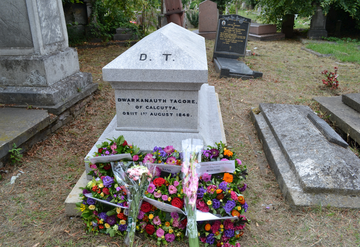
Dwarkanath Tagore
‐
Wealthy businessman and grandfather of Rabindranath Tagore who visited England in 1842 and died in London in 1846
Other names
Dwarkanath Thakur
Dwarkanauth Tagore
Dwarkanoth Tagore
Prince Dwarkanath
Place of birth
Date of arrival to Britain
Location(s)
Albermarle Street
London
W1S
United Kingdom
Place of death
London
Date of time spent in Britain
1842, 1845–6
About
Dwarkanath Tagore was a large landowner and businessman from Bengal. Born in around 1794 to a Hindu Brahmin family, he worked closely with British traders, became the first Indian bank director in 1828 and in 1834 founded Carr Tagore and Company, the first ‘equal partnership’ firm between a European and an Indian businessman.
In January 1842 Dwarkanath Tagore left Calcutta to travel to England. Already well known for his business interests in India, he met many notable people in British politics and society, including the Prime Minister Sir Robert Peel and Queen Victoria, and the writers Charles Dickens, Henry Mayhew and William Thackeray. In 1842 he was presented with the Freedom of the City in Edinburgh in recognition of his business interests, his social reform activities and support of education in India. In 1842 Dwarkanath became an honorary member of the Oriental Club in London. Following an extensive visit across England and Scotland, Dwarkanath Tagore returned to India at the end of 1842.
Dwarkanath Tagore was also involved in reinterring Rammohun Roy in the newly established private cemetery at Arnos Vale in Bristol, following Roy’s death in 1833. Roy’s body was reburied at Arnos Vale in May 1842. Dwarkanath Tagore helped raise the money to pay for a large stone chattri, designed by the artist William Prinsep, to be built over the grave. Tagore also financed two Bengali students who were among the first Indians to study medicine at University College, London, in 1845.
Dwarkanath Tagore returned to England in 1845 and met the Queen again and the Prime Minister but was beset by ill-health. On 1 August 1846 he died in his room at St George’s Hotel on Albemarle Street. His body was brought to the Kensal Green cemetery in a large convoy of carriages, followed by his young son Nagendranath, nephew Nabin Chandra Mukherji and the Bengali medical students he had financed. He was buried there with a large memorial tomb.
Dwarkanath Tagore was the father of (among others) the Bengali philosopher Debendranath Tagore and the grandfather of poet and educationalist Rabindranath Tagore.
Fisher, Michael H., Counterflows to Colonialism: Indian Travellers and Settlers in Britain 1600–1857 (Delhi: Permanent Black, 2004)
Kling, Blair B., Partner in Empire: Dwarkanath Tagore and the Age of Enterprise in Eastern India (Calcutta: Firma KLM, 1981)
Kripalani, Krishna, Dwarkanath Tagore, A Forgotten Pioneer: A Life (New Delhi: National Book Trust, 1981)
Mittra, Kissory Chand, Memoir of Dwarkanath Tagore (Calcutta: Thacker, Spink & Co., 1870)
Visram, Rozina, Asians in Britain: 400 Years of History (London: Pluto Press, 2002)
Mss Eur A146, Letter from James Meadow Rendel to Thomas Sopwith, about a visit of Dwarkanath Tagore, 1842, Asian and African Studies Reading Room, British Library, St Pancras
British Newspaper Archive
LMA/4452, Oriental Club papers, The London Archives, London
Image credit
Monument of Dwarkanath Tagore at Kensal Green Cemetery, by Chandan Guha – own work, CC BY-SA 4.0, https://commons.wikimedia.org/w/index.php?curid=71607323
